Most people would agree that the great white shark belongs at the very top of the oceanic food chain. This is an apex predator that you most definitely do not want to mess with. However, it turns out that even the mighty great white shark finds itself “prey” rather than “predator” at times. The true role of the ocean’s apex predator belongs to someone else. The killer whale hunts and eats great white sharks.
Typically, these two apex predators live and hunt in different areas of the world. In the United States, for example, orcas mainly live along the Westcoast, while great white sharks are more common along the Eastcoast. However, the tides might be turning for these two predators. This summer, a large orca was spotted in Cape Cod, an area typically booming with great white sharks. Could New England waters soon host a great white vs. killer whale battle?
Background on the Great White Shark
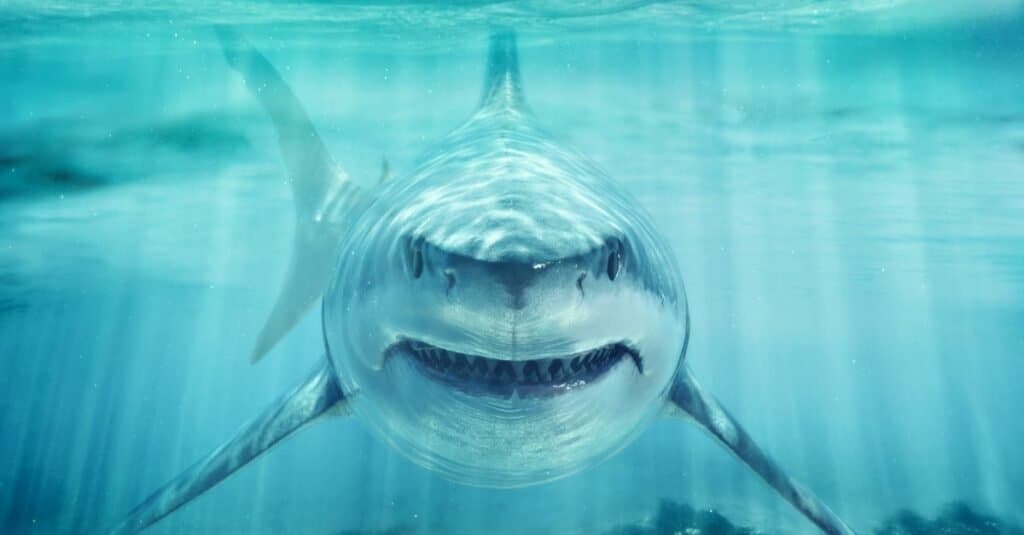
Great whites live in all major oceans and are responsible for the most unprovoked shark attacks.
©Digital Storm/Shutterstock.com
Great white sharks are apex predators with 300 sharp teeth and large, powerful bodies. They rule the oceans hunting anything from small fish to larger animals like dolphins and seals. Great white sharks can grow up to 20 feet long and weigh up to 5,000 pounds!
From the adorable great white of the 2016 children’s song “Baby Shark” to the killer star of the 1975 film Jaws, great white sharks continue to fascinate, terrify, and inspire humans around the world. However, even today there is a great deal that we still do not know about these fascinating creatures. Famous diver Ocean Ramsey even swam peacefully alongside Deep Blue, a female 20-foot great white shark. Today, great white sharks are vulnerable species and are protected by laws all over the world.
Background on Killer Whales
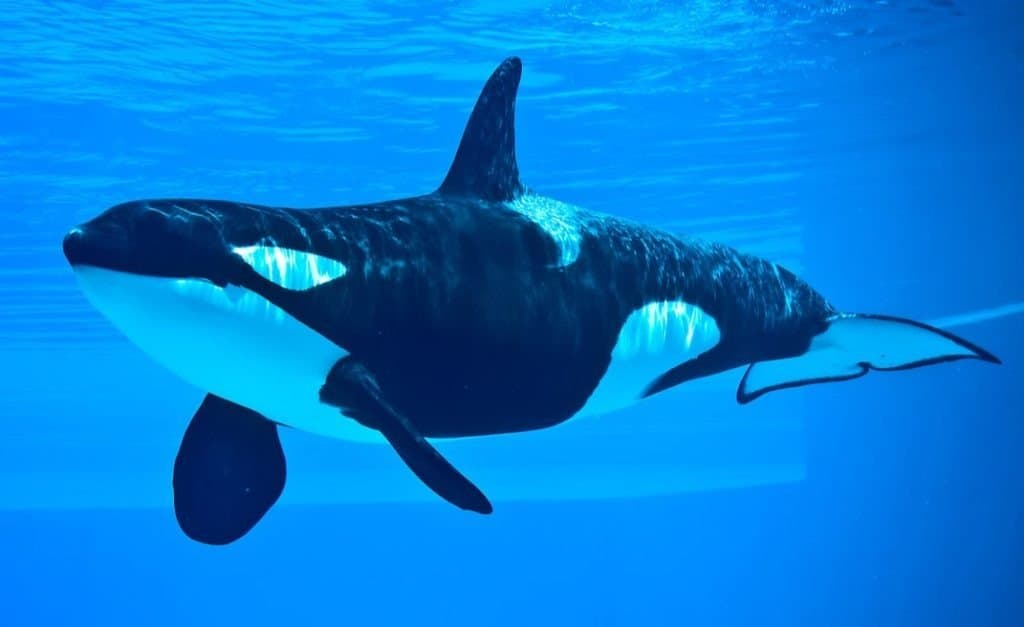
Killer whales can grow almost as long as a school bus.
©Miles Away Photography/Shutterstock.com
Orcas, also known as killer whales, are one of the most easily recognizable marine animals because of their bold black and white patterns. They are the largest members of the dolphin family, growing up to 33 feet long and weighing 22,000 pounds! Just the dorsal fin of a killer whale can grow up to 6 feet tall. Like the great white shark, killer whales are also apex predators. They eat marine mammals, fish, dolphins, and well, pretty much anything they want to.
Killer whales are at the very top of the food chain, even higher than the widely feared great white shark. They are also extremely intelligent and adaptable. They work together in pods and coordinate hunting maneuvers like an underwater pack of wolves. Killer whales are extremely social animals and live together with their family members in generational pods.
New England’s Great White Sharks
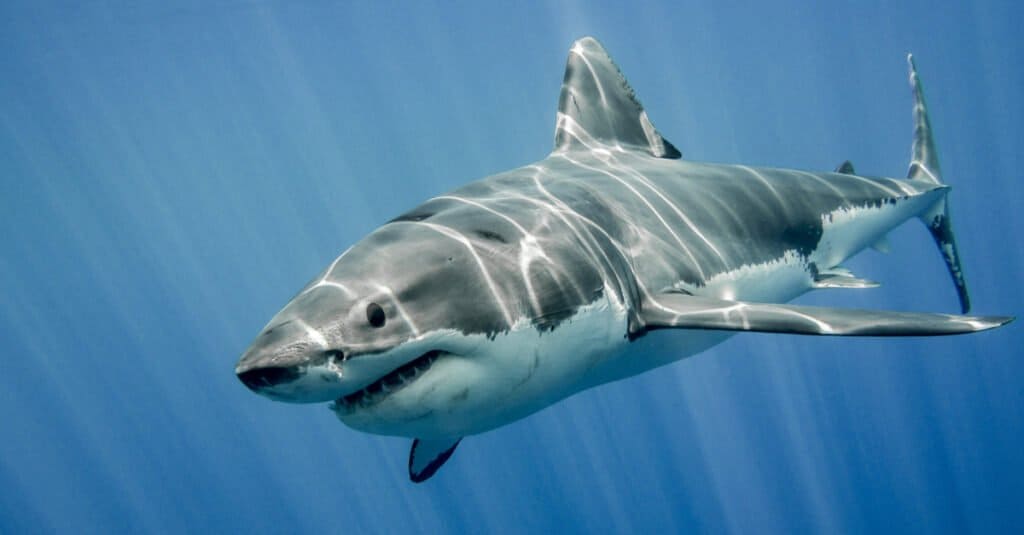
Great white sharks are cartilaginous fish with large, torpedo-shaped bodies.
©Ramon Carretero/Shutterstock.com
The waters of Cape Cod, just off the coast of Massachusetts in the United States, are a favorite gathering spot for great white sharks. In fact, there are so many sharks in this area that beaches along the coast often shut down during the spring and summer. Just last year white sharks were seen only 9 feet from the shore in some areas. Great whites are large fish, but they are willing to venture into shallow waters to catch seals. In 2021 at least 150,000 great white shark detections were recorded along the coast of Massachusetts from 132 different sharks.
One of these well-known sharks, “Andromache”, has already been spotted in Cape Cod this year. Over the next few months more sharks will join her, with their numbers reaching a peak from August through October. After that, the sharks will move on to warmer waters until next summer. New England’s coasts are popular for sharks during the summer because there are so many seals here, one of the sharks’ favorite things to eat. Today you can even book a tourist boat for “shark watching,” similar to dolphin and whale watching boat tours.
Are There Killer Whales in New England?
While sharks are a common sight along the New England coast, killer whales are a different story. Killer whales have the widest known distribution of any other mammal, second only to humans. This means that killer whales can be found in pretty much every single ocean on earth! In the United States, however, they are most common along the West Coast. To see an orca on the east coast is almost unheard of! But just this summer, a killer whale was recorded swimming about 30 miles east of Nantucket. Fisherman Jerry Leeman said the whale swam beside their boat for 30 minutes or so.
Not only is this an unusual phenomenon in New England, but it could possibly be a precursor to changes in the ecosystem here. If orcas begin frequenting the eastern coast, what might happen to the native great white sharks in the area? Is it possible that we may soon see a killer battle between these two killer species? This has never happened in Cape Cod before. However, we might be able to glean some information from shark behavior in other areas of the world.
The First Official Attack on a Great White Shark
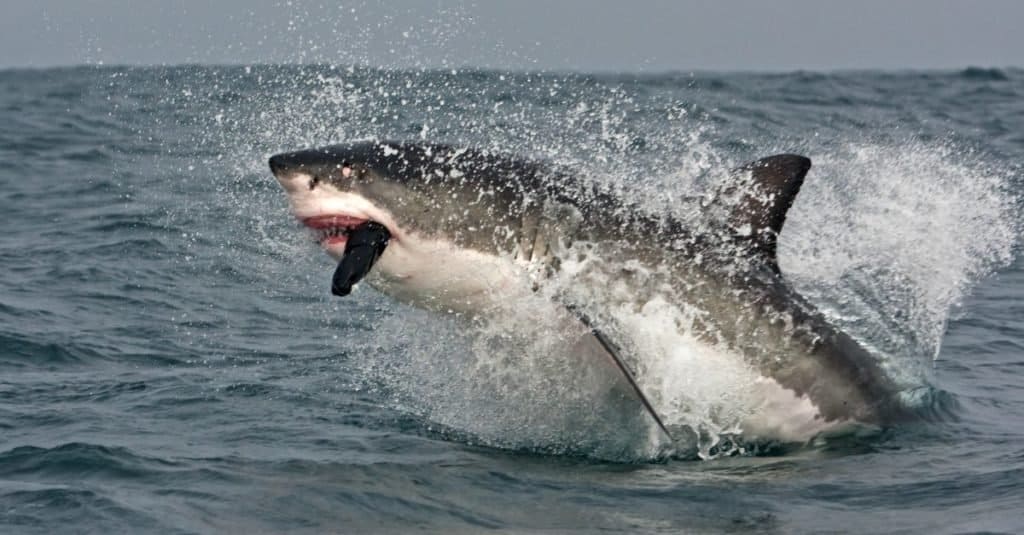
Great whites can reach speeds up to 24 km. They use their speed and coloring to help them hunt.
©Martin Prochazkacz/Shutterstock.com
On October 4, 1997, something unexpected happened—a phenomenon that for many years scientists thought might just be a fluke. For the very first time in recorded history, a great white shark was attacked and killed by a killer whale. Mary Jane Schramm was documenting humpback whales and blue whales near the Farallon Islands off San Francisco, California, when she spotted two killer whales near her boat.
One of the killer whales suddenly left the boat and headed straight for something in the distance. Within a few minutes, the large killer whale headed back towards the boat carrying an upside-down great white shark in her mouth! The sight completely shocked marine biologists. They had never seen anything quite like it before—and they would not see another for 20 more years.
Killer Whales Attack a Great White Shark in Australia
On February 2, 2015, the crew of the “Shark Warrior” headed out to the Neptune Islands of South Australia. People aboard the ship and in a submerged diving cage were observing sharks when a pod of orcas suddenly appeared in the distance. It was quickly apparent that the whales were not simply passing through. The orcas displayed very distinct and precise movements and seemed to be working together as they swam near the ship. After a few minutes, a smaller dorsal fin was spotted in the water. The crew quickly realized that the whales were corralling a great white shark!
The shark was not attempting any defensive behavior. Instead, it appeared panicked and trying to flee. Ultimately, a large female orca came down hard on top of the shark, stunning it with her force. The whales dove under the water, and immediately an oily slick appeared on the water’s surface from the shark’s organs. The whales had killed the shark, tearing it open by its pectoral fins to remove its liver.
Dr. Ingrid Visser, an orca biologist, studies killer whales off the coast of New Zealand where they hunt sevengill sharks. Sevengill sharks can grow up to 9 feet long and weigh 200 pounds. According to Dr. Visser, however, this is a relatively new prey item for killer whales. The killer whales she has observed are very precise and strategic in their attacks, illustrating their high levels of intelligence. Like the killer whales in Australia, orcas here rip off the shark’s pectoral fin right below the pectoral girdle and carefully extract the shark’s liver.
Killer Whales Battle Great White Sharks in South Africa

Orcas use echolocation to hunt in the ocean, and they have no animal predators.
©slowmotiongli/Shutterstock.com
False Bay and Seal Island are infamous gathering places for sharks near Cape Town, South Africa. Seal Island in particular, is home to large numbers of Cape fur seals and Brown fur seals. Because of this, sharks frequent the waters each year to feast on the abundant seals. Great white sharks favor this area and can be seen nearly jumping out of the water as they attack seals. Seal Island has become an ecotourism hot spot for shark watching. On average, 30 predations can be seen each day.
However, this all seemed to change when two very distinct killer whales showed up. Both whales have unusual dorsal fins that bend to the side rather than sticking straight up, so biologists named them “Port” and “Starboard”. Port’s dorsal fin falls to the left, while Starboard’s fin falls to the right. Port and Starboard commonly preyed on sevengill sharks in False Bay and near Seal Island, similar to the killer whales in New Zealand. However, in 2017 five great white sharks with tooth impressions on their pectoral fins washed up on the beaches in South Africa. All five sharks were missing their livers. Each time one of these sharks died, Port and Starboard just happened to be in the same area. Even stranger, however, was that by 2020 there was not a single great white shark to be seen in the area.
Why Do Killer Whales Attack Great White Sharks?
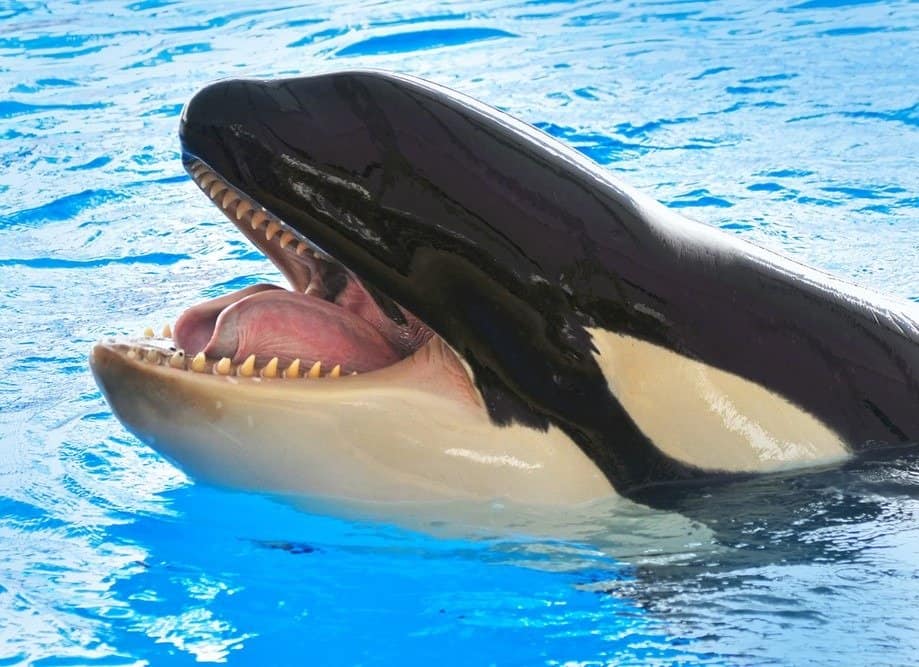
Killer whales have large, sharp teeth that measure around 3 inches and can grow up to 4 inches.
©FineShine/Shutterstock.com
We typically think of the great white shark as the ultimate apex predator of the ocean, but as we have seen, that title clearly belongs to the killer whale. However, killer whales typically go after prey animals with rich blubber, something that sharks do not have. Instead, when killer whales attack great white sharks, they are extremely precise and only target their liver.
Great white sharks have quite large livers. In fact, a shark’s liver can weigh hundreds of pounds, taking up 1/3 of the shark’s total body weight. Sharks do not have swim bladders like many other fish, so their liver helps to compensate for the lack of buoyancy. Shark livers are extremely rich in oils and fats, which makes them very buoyant. This is what causes the oily “slick line” on the surface of the water after a shark is killed by a killer whale. A shark’s liver is essentially a highly efficient energy storage organ. This makes it the perfect target for killer whales.
We do not know how long killer whales have been hunting great white sharks. However, we do know that this behavior is becoming more common. Scientists believe that this could be due to several different things. For example, shark populations have been increasing because many areas now ban shark hunting and fishing. In addition, global warming may be expanding the areas where sharks live, so they may be in closer proximity to killer whales. Global warming may also be causing a decrease in the killer whales’ usual food and nutritional sources. These whales may simply be exploring alternative meal options, like the nutrient-rich liver of a great white shark.
Why Do Great Whites Leave After a Killer Whale Attack?
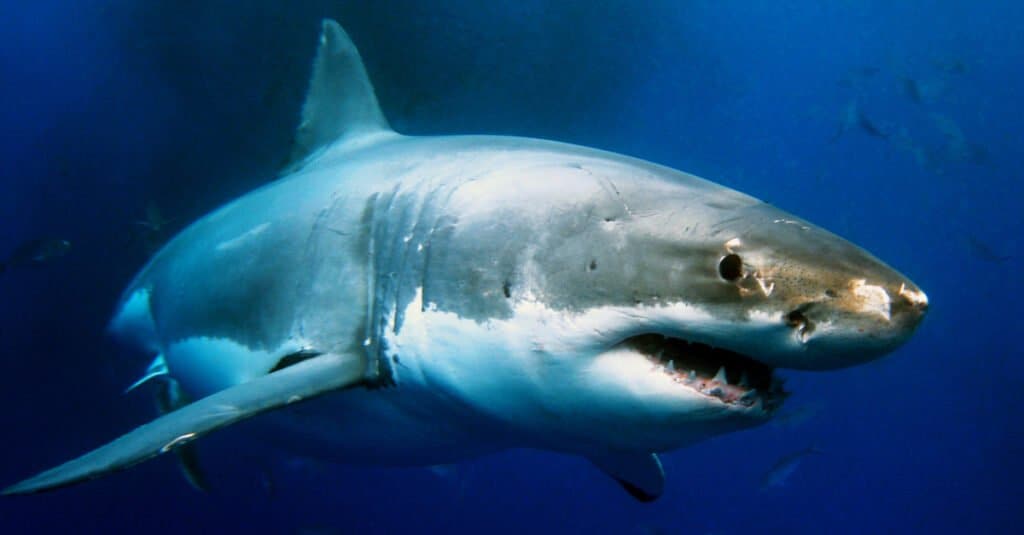
The world’s largest predatory fish, great white sharks commonly weigh a few thousand pounds.
©Alexius Sutandio/Shutterstock.com
What’s truly strange, is that after a killer whale kills a great white shark, all other great white sharks seem to disappear from the area. This is highly unusual behavior. For example, killer whales regularly hunt and kill dolphins, but the dolphins remaining do not vacate the area for weeks or months at a time. Great white sharks, on the other hand, can disappear from the area indefinitely. The great white sharks in South Africa, for instance, were tagged by scientists before Port and Starboard’s hunting rampage. After these two whales killed the great whites during 2017, all the tagged great white sharks instantly fled the area.
Although strange, researchers from a 2019 study discovered that this is typical behavior for a great white shark. Dr. Salvador Jorgensen explained, “When confronted by orcas, white sharks will immediately vacate their preferred hunting ground and will not return for up to a year, even though the orcas are only passing through”. Great white sharks, it seems, know who really sits at the top of the food chain and avoid killer whales as much as possible.
What does this mean for the great white sharks in Cape Cod? Hopefully, the recent killer whale was just passing through. But if not, we might just have another battle of the giants coming this summer in New England.
The photo featured at the top of this post is ©
Thank you for reading! Have some feedback for us? Contact the AZ Animals editorial team.







